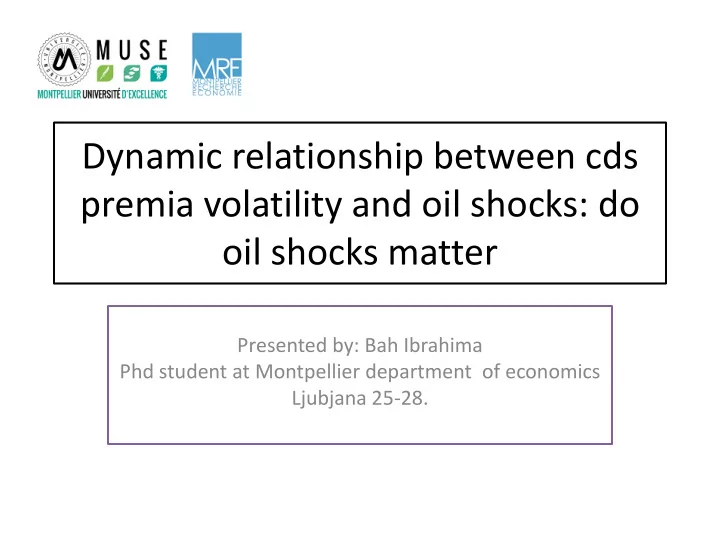

Dynamic relationship between cds premia volatility and oil shocks: do oil shocks matter Presented by: Bah Ibrahima Phd student at Montpellier department of economics Ljubjana 25-28.
Outline Part 1: Motivation. Part 2: Objectives and Related Litterature. Part 3: Methodology. Chapitre 4: Results. Chapitre 5: Discussions and policy recommendation.
Motivations Oil slump of 2014: shale oil revolution ,market strategy of Saudi Arabia? Source: CEPR
Motivations Even after the european debt crisis, the embi spreads remain at a high level: Venezuela is above the 1000 bp. Except some countries they never went back to their original level of before the global financial crisis of 2008. Source : Dauvin,2014
Objectives and Questions • The oil slump of 2014 had contributed to question the solvency of oil rich countries with the defaulting case of Venezuela . • Is the appearance of extreme events on oil market have any effect on the incertitude surrounding the solvency of oil rich countries ? • Is there a difference among countries in the perception of the credit risk that resource-rich country face in the debt market? • Does the Uncertainty about their solvency affect the price of oil? • • Do oil shocks have the same importance from one country to another on the solvency (volatility of spreads) of oil exporting countries?
Hypothesis - Hypothesis 1: Oil shocks have different effects on sovereign credit default swaps spreads of oil rich countries. - Hypothesis 2: The incertitude around the solvency of oil rich countries has an effect on oil prices and contribute to adress the question of solvency of oil rich countries. - Hypothesis 3: The slump of 2014 and the european debt crisis had affected the relationship between oil shocks and sovereign cds spreads volatility of oil rich countries.
Related litterature • Hilscher and Nosbusch (2010) find that the terms of exchange and its volatility affect the sovereign risk. • Longstaff and Al (2011) study the effects of global factors on sovereign credit risk but do not include the role of natural resources. • Hooper (2014) examines the effect oil reserves of sovereign spreads in a few couple of oil rich countries at a monthly basis. • Hooper and Chuffart (2019) study the nonlinear effect of oil prices on Venezuela and Russia sovereign cds spreads by using a markow-switching model. • Syed and Al (2017) study the directional predictability between the oil volatility index and the oil sovereign cds spreads. • Bourie and Al (2018) study the dependence between the oil price quantiles and the spreads of the sovereign cds of the oil-exporting countries. • None of these studies tried to go beyond the price or the reserves of oil in order to catch the role of oil markets fundamentals.
Methodology • Cubic spline interpolation ( to solve the mismatching between daily frequence of sovereign cds spreads and the monthly frequence of data related to the oil market ). • Testing symmetric and asymmetric conditional volatility modelling on the sample . • Structural Vector Autoregressive modelling (SVAR).
Data. - The 5 years maturity spreads of the credit defaults swaps (cds) of our 6 countries of our sample have been extracted from bloomberg. - The supply of oil have been extracted from the site of the international energy agency (iea). - The demand of oil have been proxied by the index of Lutz kilian that can been extracted from his website. - The stocks of the oil market are the ratio between the total stocks of OCDE countries reported to the stocks of the United states. This variable will represent the demand for precautionary or speculative purpose. -The deflated price of oil is obtained by dividing the price extracted from the site of international energy agency by the index of inflation. - Our sample encompasses three of the main oil rich countries in the world (Saudi Arabia, Venezuela, Russia), and three among the small one (Norway high diversified economy) and Qatar and Kazakhstan.
. . Conditional Volatility modelling * Garch(p,q) of Bollerslev (1996) Selection criteria of the best fitted model being given by the Akaike criteria Aic=2k-2lnL.
Conditional volatility modelling • The GJR-GARCH(p,q) of Jagannatan and Runkle (1993). • The EGARCH(p,q) of Nelson (1991). • The FIGARCH(p,d, q) model of Baillie and Al (1996).
Structural VAR
Structural VAR
x x x Structural VAR The first row deals with the supply innovation ,second to the demand innovation , speculative demand innovation,residual innovation and cds premia innovation X
Results of best fitted conditional volatility modelling.
Analysis of the impulse response function of cds spreads volatility of Norway to the different shocks before and after the oil slump of 2014. Graphique des fonctions de réponses impulsionnelles Pays : Venezuela sur la période 2010-2017. Choc d’offre Choc de demande Choc spéculatif choc résiduel choc de volatilité des cds Pays : Venezuela sur la période 2010-2014. Choc d’offre Choc de demande Choc spéculatif choc résiduel choc de volatilité des cds Pays : Venezuela sur la période 2014-2017.
Analysis of the impulse response function of cds premia volatility of Norway to the different shocks before and after the oil slump of 2014. Pays : Norvège sur la période 2010-2017. Choc d’offre Choc de demande Choc spéculatif choc résiduel choc de volatilité des cds Pays : Norvège sur la période 2010-2014. Choc d’offre Choc de demande Choc spéculatif choc résiduel choc de volatilité des cds Pays : Norvège sur la période 2010-2014. Choc d’offre Choc de demande Choc spéculatif choc résiduel choc de volatilité des cds
Recommend
More recommend